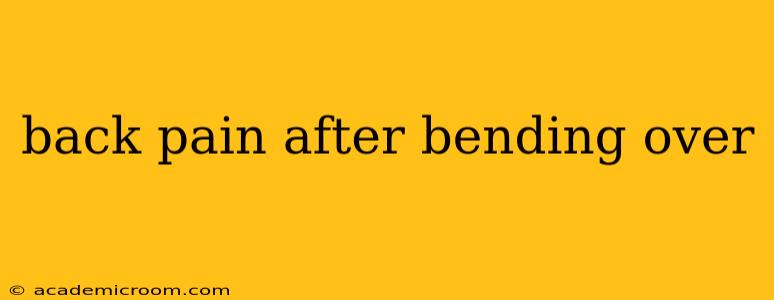Back pain after bending over is a common complaint, affecting people of all ages and activity levels. While often temporary and easily resolved, understanding the potential causes and implementing preventative measures is crucial for long-term back health. This comprehensive guide explores the various reasons why you might experience back pain after bending and provides practical advice for managing and preventing future episodes.
What Causes Back Pain After Bending Over?
The pain you feel after bending can stem from a variety of sources, ranging from minor muscle strains to more serious conditions. Let's examine some of the most frequent culprits:
-
Muscle Strains and Sprains: This is the most common cause. Bending, especially if done improperly or repeatedly, can overstretch or tear muscles and ligaments in your back, leading to pain, stiffness, and limited movement. This is particularly true if you lift heavy objects while bending.
-
Disc Problems: The intervertebral discs act as cushions between your vertebrae. Bending, particularly with twisting, can put pressure on these discs, potentially causing them to bulge, herniate, or degenerate. This can lead to radiating pain down your leg (sciatica) in addition to back pain.
-
Facet Joint Dysfunction: These joints connect your vertebrae and can become irritated or inflamed from bending, especially repetitive bending. This irritation can lead to pain and stiffness.
-
Spinal Stenosis: This condition involves a narrowing of the spinal canal, putting pressure on nerves. Bending can exacerbate this pressure, causing pain.
-
Osteoarthritis: This degenerative joint disease affects the cartilage in your spine. Bending can increase stress on these joints, leading to increased pain and stiffness.
-
Poor Posture: Consistently poor posture, even before bending, can contribute to back pain. Poor posture weakens supporting muscles, making them more susceptible to injury when bending.
How Long Does Back Pain After Bending Last?
The duration of back pain after bending varies significantly depending on the cause and severity of the injury. Minor muscle strains often resolve within a few days to a couple of weeks with rest and self-care measures. However, more serious conditions like herniated discs or spinal stenosis may require more extensive treatment and could result in prolonged pain.
What to do if back pain persists?
If your back pain persists for more than a few weeks, worsens significantly, or is accompanied by other symptoms like numbness, tingling, weakness, or bowel/bladder dysfunction, seek immediate medical attention. These could indicate a more serious underlying condition requiring professional diagnosis and treatment.
How to Treat Back Pain After Bending Over
Treatment for back pain after bending depends largely on the underlying cause. However, some common approaches include:
-
Rest: Avoid activities that aggravate your pain. Gentle movement is usually better than complete bed rest.
-
Ice and Heat: Applying ice initially can help reduce inflammation, followed by heat to relax muscles.
-
Over-the-Counter Pain Relievers: Medications like ibuprofen or naproxen can help manage pain and inflammation.
-
Stretching and Exercise: Gentle stretches and exercises, particularly those that strengthen your core muscles, can help improve back flexibility and stability. A physical therapist can guide you on appropriate exercises.
-
Professional Treatment: Depending on the diagnosis, your doctor might recommend physical therapy, chiropractic care, injections, or surgery.
Can I Prevent Back Pain From Bending?
Preventing back pain related to bending is achievable through conscious effort and lifestyle modifications:
-
Proper Lifting Technique: Always bend at your knees and hips, keeping your back straight, when lifting objects. Use your leg muscles, not your back muscles, to lift.
-
Maintain Good Posture: Pay attention to your posture throughout the day, whether sitting, standing, or walking. Regular posture checks can make a significant difference.
-
Strengthen Core Muscles: Strong abdominal and back muscles provide crucial support for your spine. Regular core strengthening exercises are essential.
-
Regular Exercise: Maintaining overall fitness improves flexibility, strength, and endurance, making your back less vulnerable to injury.
-
Ergonomic Workplace: Ensure your workspace is ergonomically designed to support good posture and minimize strain on your back.
What are the best exercises for back pain after bending?
Gentle exercises focusing on core strengthening and flexibility are recommended. These may include:
-
Pelvic tilts: These help strengthen abdominal muscles and improve posture.
-
Knee-to-chest stretches: These gently stretch the lower back muscles.
-
Cat-cow stretches: This yoga-based exercise improves spinal mobility and flexibility.
-
Plank variations: This exercise strengthens core muscles which are vital for supporting the back.
Disclaimer: It's crucial to consult with a healthcare professional or physical therapist before starting any new exercise program, particularly if you are experiencing back pain. They can assess your specific condition and recommend appropriate exercises to avoid further injury.
Does back pain after bending mean I have a serious problem?
Not necessarily. Most back pain after bending is caused by minor muscle strains and resolves quickly with rest and self-care. However, persistent, severe, or worsening pain, accompanied by other symptoms, may indicate a more serious underlying condition that requires medical attention.
When should I see a doctor for back pain after bending?
Seek medical attention if:
- Your pain is severe and doesn't improve after a few days of rest and self-care.
- Your pain radiates down your leg(s).
- You experience numbness, tingling, or weakness in your legs or feet.
- You have bowel or bladder dysfunction.
- Your pain is accompanied by fever or unexplained weight loss.
This information is for general knowledge and does not constitute medical advice. Always consult with a healthcare professional for diagnosis and treatment of any medical condition.
